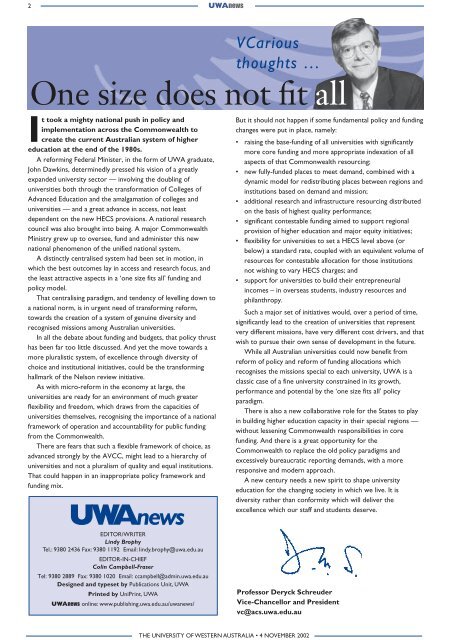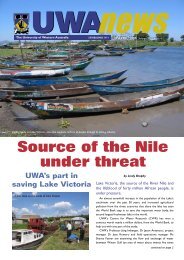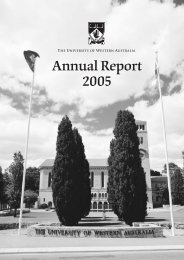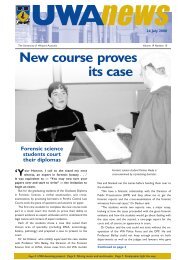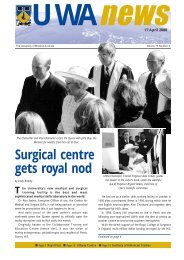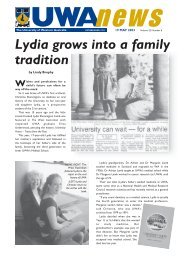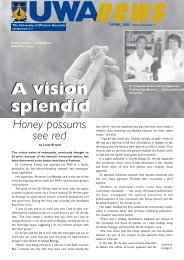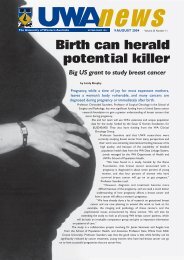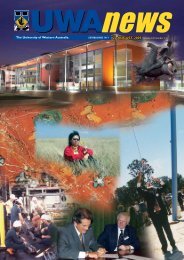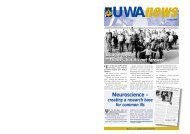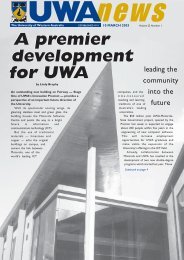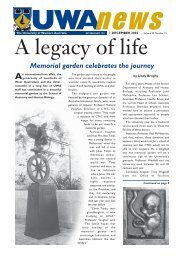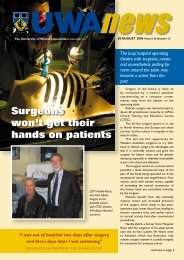WERB news 4 Nov - Publications Unit - The University of Western ...
WERB news 4 Nov - Publications Unit - The University of Western ...
WERB news 4 Nov - Publications Unit - The University of Western ...
Create successful ePaper yourself
Turn your PDF publications into a flip-book with our unique Google optimized e-Paper software.
2 UWA<strong>news</strong>VCariousthoughts …One size does not fit allIt took a mighty national push in policy andimplementation across the Commonwealth tocreate the current Australian system <strong>of</strong> highereducation at the end <strong>of</strong> the 1980s.A reforming Federal Minister, in the form <strong>of</strong> UWA graduate,John Dawkins, determinedly pressed his vision <strong>of</strong> a greatlyexpanded university sector — involving the doubling <strong>of</strong>universities both through the transformation <strong>of</strong> Colleges <strong>of</strong>Advanced Education and the amalgamation <strong>of</strong> colleges anduniversities — and a great advance in access, not leastdependent on the new HECS provisions. A national researchcouncil was also brought into being. A major CommonwealthMinistry grew up to oversee, fund and administer this newnational phenomenon <strong>of</strong> the unified national system.A distinctly centralised system had been set in motion, inwhich the best outcomes lay in access and research focus, andthe least attractive aspects in a ‘one size fits all’ funding andpolicy model.That centralising paradigm, and tendency <strong>of</strong> levelling down toa national norm, is in urgent need <strong>of</strong> transforming reform,towards the creation <strong>of</strong> a system <strong>of</strong> genuine diversity andrecognised missions among Australian universities.In all the debate about funding and budgets, that policy thrusthas been far too little discussed. And yet the move towards amore pluralistic system, <strong>of</strong> excellence through diversity <strong>of</strong>choice and institutional initiatives, could be the transforminghallmark <strong>of</strong> the Nelson review initiative.As with micro-reform in the economy at large, theuniversities are ready for an environment <strong>of</strong> much greaterflexibility and freedom, which draws from the capacities <strong>of</strong>universities themselves, recognising the importance <strong>of</strong> a nationalframework <strong>of</strong> operation and accountability for public fundingfrom the Commonwealth.<strong>The</strong>re are fears that such a flexible framework <strong>of</strong> choice, asadvanced strongly by the AVCC, might lead to a hierarchy <strong>of</strong>universities and not a pluralism <strong>of</strong> quality and equal institutions.That could happen in an inappropriate policy framework andfunding mix.UWA<strong>news</strong>EDITOR/WRITERLindy BrophyTel.: 9380 2436 Fax: 9380 1192 Email: lindy.brophy@uwa.edu.auEDITOR-IN-CHIEFColin Campbell-FraserTel: 9380 2889 Fax: 9380 1020 Email: ccampbell@admin.uwa.edu.auDesigned and typeset by <strong>Publications</strong> <strong>Unit</strong>, UWAPrinted by UniPrint, UWAUWA<strong>news</strong> online: www.publishing.uwa.edu.au/uwa<strong>news</strong>/But it should not happen if some fundamental policy and fundingchanges were put in place, namely:• raising the base-funding <strong>of</strong> all universities with significantlymore core funding and more appropriate indexation <strong>of</strong> allaspects <strong>of</strong> that Commonwealth resourcing;• new fully-funded places to meet demand, combined with adynamic model for redistributing places between regions andinstitutions based on demand and mission;• additional research and infrastructure resourcing distributedon the basis <strong>of</strong> highest quality performance;• significant contestable funding aimed to support regionalprovision <strong>of</strong> higher education and major equity initiatives;• flexibility for universities to set a HECS level above (orbelow) a standard rate, coupled with an equivalent volume <strong>of</strong>resources for contestable allocation for those institutionsnot wishing to vary HECS charges; and• support for universities to build their entrepreneurialincomes – in overseas students, industry resources andphilanthropy.Such a major set <strong>of</strong> initiatives would, over a period <strong>of</strong> time,significantly lead to the creation <strong>of</strong> universities that representvery different missions, have very different cost drivers, and thatwish to pursue their own sense <strong>of</strong> development in the future.While all Australian universities could now benefit fromreform <strong>of</strong> policy and reform <strong>of</strong> funding allocations whichrecognises the missions special to each university, UWA is aclassic case <strong>of</strong> a fine university constrained in its growth,performance and potential by the ‘one size fits all’ policyparadigm.<strong>The</strong>re is also a new collaborative role for the States to playin building higher education capacity in their special regions —without lessening Commonwealth responsibilities in corefunding. And there is a great opportunity for theCommonwealth to replace the old policy paradigms andexcessively bureaucratic reporting demands, with a moreresponsive and modern approach.A new century needs a new spirit to shape universityeducation for the changing society in which we live. It isdiversity rather than conformity which will deliver theexcellence which our staff and students deserve.Pr<strong>of</strong>essor Deryck SchreuderVice-Chancellor and Presidentvc@acs.uwa.edu.auTHE UNIVERSITY OF WESTERN AUSTRALIA • 4 NOVEMBER 2002


